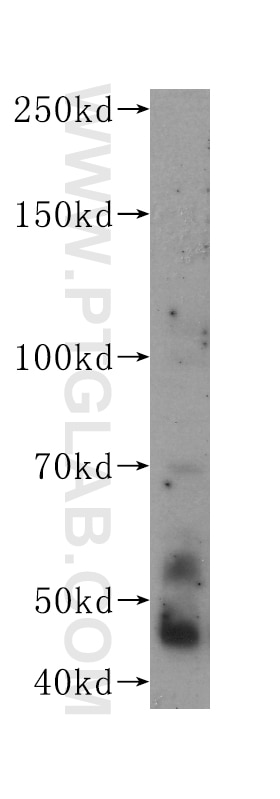FOXP3 Monoklonaler Antikörper
FOXP3 Monoklonal Antikörper für ELISA
Wirt / Isotyp
Maus / IgM
Getestete Reaktivität
Affe, human, Maus, Ratte
Anwendung
IF, ELISA
Konjugation
Unkonjugiert
CloneNo.
7B6A8
Kat-Nr. : 60149-1-Ig
Synonyme
Geprüfte Anwendungen
Veröffentlichte Anwendungen
| IF | See 1 publications below |
Produktinformation
60149-1-Ig bindet in IF, ELISA FOXP3 und zeigt Reaktivität mit Affe, human, Maus, Ratten
| Getestete Reaktivität | Affe, human, Maus, Ratte |
| In Publikationen genannte Reaktivität | human |
| Wirt / Isotyp | Maus / IgM |
| Klonalität | Monoklonal |
| Typ | Antikörper |
| Immunogen | Peptid |
| Vollständiger Name | forkhead box P3 |
| Berechnetes Molekulargewicht | 47 kDa |
| Beobachtetes Molekulargewicht | 48 kDa |
| GenBank-Zugangsnummer | NM_014009 |
| Gene symbol | FOXP3 |
| Gene ID (NCBI) | 50943 |
| Konjugation | Unkonjugiert |
| Form | Liquid |
| Reinigungsmethode | Protein-A-Reinigung |
| Lagerungspuffer | PBS with 0.02% sodium azide and 50% glycerol |
| Lagerungsbedingungen | Bei -20°C lagern. Nach dem Versand ein Jahr lang stabil Aliquotieren ist bei -20oC Lagerung nicht notwendig. 20ul Größen enthalten 0,1% BSA. |
Hintergrundinformationen
FOXP3, also named as IPEX, JM2 and Scurfin, is a transcription factor. POXP3 plays a critical role in the control of immune response. Defects in FOXP3 are the cause of immunodeficiency polyendocrinopathy, enteropathy, X-linked syndrome (IPEX)]; also known as X-linked autoimmunity-immunodeficiency syndrome. IPEX is characterized by neonatal onset insulin-dependent diabetes mellitus, infections, secretory diarrhea, trombocytopenia, anemia and eczema. It is usually lethal in infancy. This antibody is a mouse monoclonal antibody raised against a peptide mapping within human FOXP3.


